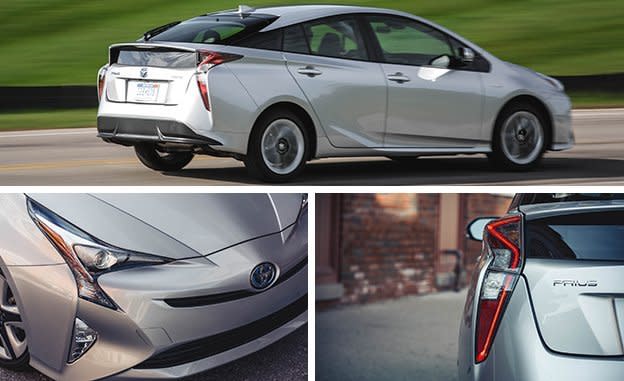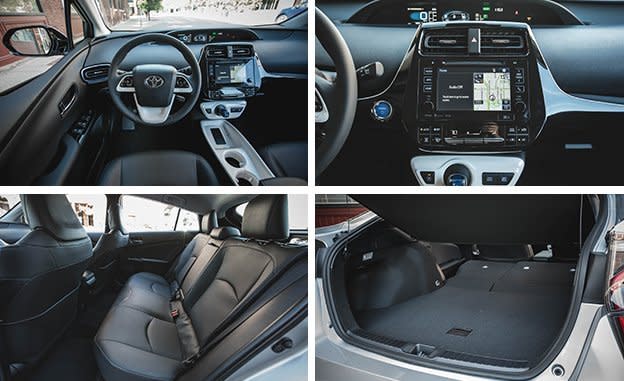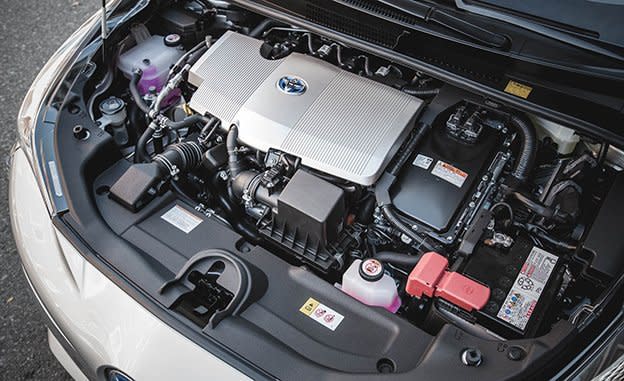2017 Toyota Prius Three Touring

It takes serious smarts to design and manufacture a 3100-pound car that sips fuel so miserly that it can cover to 54 miles on a single gallon of gasoline. That’s a little more than two shotglasses of 87 octane for every 5280 feet traveled, a technical feat that is every bit as impressive as pushing a Bugatti Chiron through the atmosphere at 261 mph. Yet for all the brainpower that went into making the Toyota Prius America’s most efficient car without a plug, the company still bungled the simplest math. When it came time to parse the trims, the marketers skipped one and started counting from two. That makes this particular Toyota Prius Three Touring, sandwiched between the Two and Four, the mid-level trim.
The Slightest of Upgrades
The difference between the base Prius Two and the Three Touring is the difference between shopping at Walmart and at Target. It will feel like a significant upgrade only to those who have never experienced true luxury. Beyond the standard Prius accoutrements—few frills but everything you need—the Three adds Toyota’s SofTex faux-leather wraps for the steering wheel and the door armrests, chrome and glossy plastic interior accents, inductive phone charging, and a larger, high-resolution 7.0-inch touchscreen (up from 6.1 inches in the Prius Two). The latter brings satellite radio and Toyota’s Entune app suite, which offers Pandora and iHeartRadio integration (no Toyota currently offers Apple CarPlay or Android Auto connectivity). Stepping up from the Three to the Three Touring nets SofTex seat upholstery and power adjustability for the fronts—six-way for the driver and four-way for the passenger.

The interior is best described as being finished with the nicest materials for the lowest cost without being blatantly cheap. That’s essentially the strategy for any modern car, but hybrids and electric vehicles take the game one notch higher as the bean counters aim to offset the extra expense of the powertrain with cheaper cosmetic bits.
The Prius benefits from a cockpit that feels wider and taller, and thus airier, than competitors such as the Chevrolet Volt and the upcoming Hyundai Ioniq. The simple, sleek glossy bits borrow heavily from Silicon Valley’s best products of a decade ago, and while they’re neither upscale nor particularly fashion forward, this Prius’s interior does look more stylish than those of Priuses past. Most important, the cabin lives up to the Three Touring’s $28,980 price, so you’ll never feel like you’re sacrificing comfort or convenience for high mpg.
That’s assuming you can walk up to a Prius without looking at it. We expect many people will never appreciate the Prius’s interior simply because they won’t be able to see past the tortured exterior styling. The design is a product of CEO Akio Toyoda’s push to inject more emotion into the company’s cars, yet the main emotion stirring most of us laying eyes on the Prius is revulsion. More styling does not equal better styling.

A Nicer Prius Still Is a Prius
The mechanical pieces that make a Prius a Prius are uniform across the lineup, save for the battery. A 1.8-liter four-cylinder mates to two electric motor/generators and a complex planetary gearset to produce a combined 121 horsepower. The 0.7-kWh lithium-ion battery in our test car is an upgrade over the heavier nickel-metal-hydride pack in the base model. It’s used here not to improve the performance or efficiency but to offset the weight increase of the additional convenience features in higher trim levels.
We’d previously tested the Prius Two Eco, which is rated by the EPA at 56 mpg combined versus the rest of the line’s 52 mpg. That boost is made possible through improving the car’s efficiency—low-rolling-resistance tires inflated to higher pressures, the weight savings of removing the spare tire—and EPA off-cycle credits, namely a solar-reflecting windshield intended to reduce the workload on the air conditioner. In our possession, the Three Touring notched 42 mpg, 5 mpg below what we observed in the Prius Two Eco. It appears that the Two Eco’s changes are good for a tangible uptick in fuel economy, all at a $2950 discount from the Three Touring.

Toyota has made strides with this fourth-generation Prius in quieting the labored moans of its earlier hybrids. Ride quality improves with the adoption of a multilink rear suspension that offers more compliance than the old torsion-beam design. There’s still room for improvement in wind and road noise, but overall the Prius now drives much more like the near-$30,000 car it is. That’s a boon for fuel-conscious pinchpennies, but a better Prius remains unlikely to win over car enthusiasts. Our Prius Three Touring took a leisurely 10.5-second stroll to reach 60 mph. While we once thought this was the price for frugal fuel consumption, cars like the Chevrolet Volt prove that you can sip gas most of the time and still keep up with conventionally powered econoboxes when pulling away from stoplights.
The Prius no longer is the spirit-crushing standard in slow, noisy, and busy motoring. It may continue to be painfully slow, but the latest generation improves on comfort in big ways that make opting for this fuel-efficient alternative over a mid-size sedan more logical, even if the trim-level naming scheme isn’t.
Specifications >
VEHICLE TYPE: front-engine, front-wheel-drive, 5-passenger, 4-door hatchback
PRICE AS TESTED: $28,980 (base price: $28,980)
ENGINE TYPE: DOHC 16-valve Atkinson-cycle 1.8-liter inline-4, 95 hp, 105 lb-ft; permanent-magnet synchronous AC electric motor, 71 hp, 120 lb-ft; combined output, 121 hp; 0.7-kWh lithium-ion battery pack
TRANSMISSION: continuously variable automatic
DIMENSIONS:
Wheelbase: 106.3 in
Length: 178.7 in
Width: 69.3 in Height: 58.1 in
Passenger volume: 93 cu ft
Cargo volume: 25 cu ft
Curb weight: 3113 lb
C/D TEST RESULTS:
Zero to 60 mph: 10.5 sec
Zero to 100 mph: 30.6 sec
Zero to 110 mph: 43.2 sec
Rolling start, 5-60 mph: 10.3 sec
Top gear, 30-50 mph: 4.7 sec
Top gear, 50-70 mph: 7.6 sec
Standing ¼-mile: 17.8 sec @ 79 mph
Top speed (drag limited): 114 mph
Braking, 70-0 mph: 180 ft
Roadholding, 300-ft-dia skidpad: 0.82 g
FUEL ECONOMY:
EPA combined/city/highway driving: 52/54/50 mpg
C/D observed: 42 mpg
C/D observed 75-mph highway driving: 46 mpg
C/D observed highway range: 510 mi

 Yahoo Autos
Yahoo Autos 